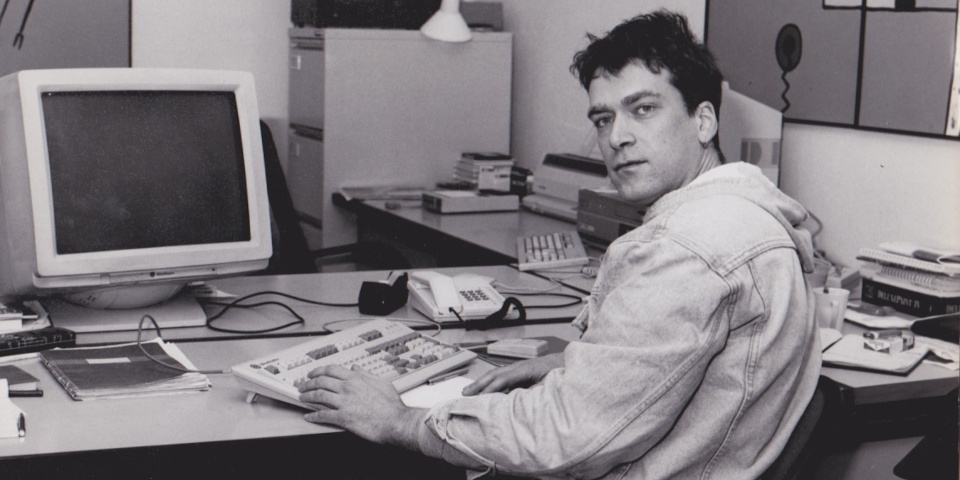
Ton Roosendaal to step down as Blender chairman and CEO
www.cgchannel.com
html PUBLIC "-//W3C//DTD HTML 4.0 Transitional//EN" "http://www.w3.org/TR/REC-html40/loose.dtd"The keynote from this weeks Blender Conference, during which Ton Roosendaal the original creator of the open-source 3D software announced that he is standing down as Blender CEO.Ton Roosendaal is to step down as chairman of the Blender Foundation and Blender CEO on 1 January 2026. The news was announced during todays keynote at the Blender Conference.Roosendaal the original author of the open-source 3D software, and its public figurehead for the past three decades will pass on his roles to current Blender COO Francesco Siddi.Roosendaal himself will move to the newly established Blender Foundation supervisory board.Other new Blender Foundation board positions include Head of Development Sergey Sharybin, Head of Product Dalai Felinto, and Head of Operations Fiona Cohen.Ton Roosendaal in the early 1990s. Blender originated as in-house software at NeoGeo, the animation studio he co-founded.Blenders original creator and principal promoterBlender began life in the mid-1990s as in-house software at NeoGeo, the Dutch animation studio that Roosendaal co-founded, and for which he wrote the custom tools.Although initially set to become a commercial product, when investors decided to pull the plug on Not a Number, the firm he had founded to develop Blender, Roosendaal went open-source. A crowdfunding campaign quickly raised the 110,000 needed to buy back the code base, and on 13 October 2002, Blender was released to the world under a GPL licence.From the start, two things distinguished Blender from most other open-source CG applications.First, even before the first release, Roosendaal established the non-profit Blender Foundation, so development was run through an organization akin to a commercial software developer.Second, the software was tested in something close to real-world production conditions, on a series of open movies, beginning with 2006s Elephants Dream, and continuing to this day.The early open movies funded through a combination of DVD pre-sales and arts grants also provided valuable exposure for Blender, and illustrated Roosendaals gifts as a producer and promoter: a mixture of passion, physical presence, and sheer force of personality.Taking Blender from fan favorite to staple of professional productionBy the mid-2010s, Blender was quietly being adopted in major studios, with Pixar confirming that it was one of a small number of third-party 3D tools that it approved for use internally.A major turning point was the release of Blender 2.80: the 2019 update that addressed many of the UI and workflow issues that had previously alienated artists used to commercial 3D apps.It catalysed support for Blender among big tech firms, with a landmark $1.2 million grant from Epic Games followed by backing from companies including AMD, Intel, NVIDIA and Qualcomm.Last year, the Corporate Patrons of the Blender Development Fund accounted for just under 40% of the collective income of the Blender organizations.The resulting 3.1 million paid the salaries of over 15 full-time developers, plus a similar number of tech support staff and part-time devs: a larger team than many commercial CG tools.Roosendaal (right) introduces the new Blender leadership team: (L-R) incoming CEO Francesco Siddi, Sergey Sharybin, Dalai Felinto and Fiona Cohen.The public incarnation of BlenderDuring that time, the software has been closely identified with Roosendaal himself, both through his role as chairman of the Blender Foundation, and as a kind of totemic figurehead.When I interviewed him in 2019 for an article in a UK tech magazine, he described himself, quite accurately, as the incarnation of Blender.But in the same interview, he noted that Blender is much bigger than me and commented: Now I need to get the organisation working without me, and then I can move on.Six years later, those plans have finally come to fruition, with the appointment of a new Blender leadership team.From single figurehead to four core leadership rolesAnnouncing his departure at the Blender Conference, Roosendaal identified four of his key skills that he felt had led to Blenders success: as an organizer, developer, designer and entrepreneur.Its telling that rather than trying to appoint one person to fulfil all four roles, they have been split out to four separate people.Former animation producer Fiona Cohen takes on the organizational role, as the Blender Foundations new Head of Operations. The developer role will be taken by Blender Lead Engineer Sergey Sharybin in his new role as the Foundations Head of Development.The designer role passes to another long-time Blender artist and developer, Dalai Felinto, as the new Head of Product.The critical entrepreneurial role will be fulfilled by current Blender COO Francesco Siddi, who takes on Roosendaals job tiles of chairman and CEO.Siddi first began working with the Blender organization in 2012, as a VFX artist on the open movie Tears of Steel, later acting as a web developer and pipeline developer.He began working as a producer on subsequent open movies in 2017, and has managed Blenders industry relations since 2020.I am very proud to have such a wonderfully talented young team around me to bring our free and open source project into the next decade, commented Roosendaal.Read the official announcement that Ton Roosendaal is stepping down as Blender CEORead more about Blenders leadership structure in the latest Blender Foundation annual report
0 Kommentare
·0 Geteilt



